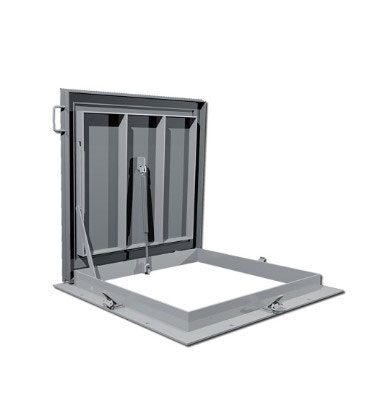Flooding is a common and destructive natural disaster that can cause significant damage to properties and infrastructure. Implementing a robust flood protection system is crucial for minimizing the impact of floods. Among the different components of this kind of system, flood-tight floor access doors play a pivotal role. These doors create a watertight seal, preventing water infiltration through floor openings. In this article, we will delve into the topic of flood protection systems and explore how to utilize flood-tight floor access doors for optimal flood prevention effectively.

Understanding Flood Tight Floor Access Doors
Flood-tight floor access doors, often called BA-A-FPS flood-tight floor access doors, are engineered to withstand the pressure exerted by floodwaters and maintain a secure seal.
They typically install in areas prone to flooding, such as basements, utility rooms, or other below-grade locations.
These doors use durable materials like stainless steel or aluminum, ensuring strength and water penetration resistance.

Importance of Flood Tight Floor Access Doors
- Water Ingress Prevention: The primary function of flood-tight floor access doors is to prevent water ingress during flooding. By creating a watertight seal, they act as a crucial barrier against floodwaters, protecting the interior of the building and its occupants.
- Structural Integrity: Flood-tight floor access doors designs to withstand the forces exerted by floodwaters, ensuring the structural integrity of the building. By resisting water pressure, these doors minimize the risk of structural damage and maintain the stability of the property.
- Seamless Integration: Flood-tight floor access doors can seamlessly integrate into the overall flood protection system of a building. They work with other flood mitigation measures, such as flood barriers or waterproofing treatments, to create a comprehensive defense against flooding.
Effective Utilization of Flood-Tight Floor Access Doors
- Strategic Placement: Proper placement of flood-tight floor access doors is essential for effective utilization. They should strategically install areas prone to flooding, such as basement entrances or utility access points. Identifying vulnerable floor openings and correctly positioning the doors will maximize their flood protection capabilities.
- Professional Installation: Engaging professionals with expertise in flood protection systems to install flood-tight floor access doors is crucial. These experts can ensure the doors are correctly fit and sealed, minimizing the risk of leaks or water infiltration. Professional installation also makes sure that all building codes and rules apply.
- Regular Maintenance: Regularly maintaining equipment is crucial to the optimal performance of flood-tight floor access doors. Routine inspections should conduct to check for any signs of damage, such as worn-out gaskets or corroded components. Timely repairs and replacements will maintain the integrity of the doors and extend their lifespan.
- Integration with Flood Monitoring Systems: Integrating flood-tight floor access doors with advanced flood monitoring systems can enhance their effectiveness. These monitoring systems can provide real-time data on water levels and trigger automated responses, such as closing flood-tight doors when a particular threshold reaches. This integration ensures a swift and proactive response to potential flooding events.
- Testing and Drills: Regular testing and drills are essential to verify the functionality of flood-tight floor access doors and familiarize personnel with their operation. These exercises simulate real-life flood scenarios, allowing individuals to practice the proper opening, closing, and securing procedures. Testing and drills help find operating problems and ensure reasonable steps takes quickly and well when a flood happens.
- Emergency Preparedness: Effective utilization of flood-tight floor access doors involves developing a comprehensive emergency preparedness plan. This plan should explain what to do in a flood, such as how to turn on flood safety measures and leave the area. Ensuring that all relevant personnel are trained on emergency protocols and can access emergency contact information is crucial for a coordinated response.
The Role of Building Codes and Regulations
Adherence to construction norms and regulations is necessary to operate flood-tight floor access doors properly. Building codes specify the minimum requirements for flood protection measures in flood-prone areas, including installing flood-tight doors. These codes outline the flood resistance rating that flood-tight doors must meet, indicating the maximum water pressure they can withstand without compromising their integrity. Compliance with these ratings ensures that the flood-tight doors can effectively resist floodwaters and prevent water infiltration into the building.
Moreover, building codes may also dictate the installation height of flood-tight floor access doors. This height is determined based on flood zone classifications and anticipated flood levels. Property owners can ensure sufficient protection against potential floodwaters by installing the doors at the appropriate elevation.
Maintenance and Inspection Procedures
Regular maintenance and inspection procedures should implement to maintain the functionality and effectiveness of flood-tight floor access doors. These procedures aim to identify any visible symptoms of wear and tear that could undermine the doors’ ability to perform their function to provide a watertight seal.
During routine maintenance, it is essential to check the condition of the door’s gaskets and compression seals. These components are crucial in creating a tight seal and preventing water infiltration. If any damage or deterioration is detected, the gaskets and seals should promptly replace to maintain the door’s integrity.
In addition, hinges, locks, and other mechanical components of flood-tight floor access doors should lubricate regularly to ensure smooth operation. Lubrication helps to prevent rust and corrosion, which can negatively impact the door’s functionality over time.
Regular inspections should also examine the surrounding floor area for any signs of water leakage or seepage. If water observes around the door or vicinity, it may indicate a problem with the seal or the floor’s waterproofing. Taking care of these problems will stop any more harm from occurring and will keep the flood protection system functioning at its optimal level.
Training and Emergency Preparedness
Proper training of personnel responsible for operating flood-tight floor access doors is crucial for effective utilization during flood emergencies. These individuals should be familiar with the door’s operation, including opening, closing, and securing procedures. They should also train to recognize signs of flooding and understand the protocols for activating the flood protection system.
Regular training and drills can help reinforce these procedures and ensure everyone is ready to act reasonably in an emergency. Simulating flood scenarios and practicing the swift closure and securing of the flood-tight doors can improve response times and reduce the risk of errors during an actual flood event.
Additionally, emergency preparedness plans should develop to outline the specific actions to take during a flood. These plans should include clear communication channels, evacuation procedures, and coordination with emergency responders. Property owners can optimize their flood protection efforts and minimize potential damages by integrating flood-tight floor access doors into the emergency preparedness plan.
Advancements in Flood Protection Technology
The field of flood protection technology is continuously evolving, and advancements in flood-tight floor access doors contribute to their effectiveness in preventing water ingress. Through ongoing study and development, these doors are getting more robust, reliable, and lasting.
Innovations in door construction materials and design aim to improve their resistance to water pressure and increase their lifespan. For example, using corrosion-resistant materials and improved sealing mechanisms can enhance the doors’ ability to withstand prolonged exposure to floodwaters.
Moreover, technological developments have resulted in the creation of automated flood protection systems. These systems utilize sensors and monitoring devices to detect rising water levels and automatically activate flood-tight floor access doors when necessary. This automation reduces the reliance on human intervention and swiftly responds to flood events.
Collaboration and Community Engagement
Effectively utilizing flood-tight floor access doors requires collaboration and engagement with the broader community. In flood-prone areas, community-wide flood protection measures are essential to reduce the overall risk and impact of flooding.
Collaboration with local authorities, flood management agencies, and neighboring properties can lead to shared flood protection initiatives. It may include implementing coordinated flood response plans, sharing resources and information, and advocating for improved flood mitigation infrastructure.
Public awareness campaigns can also play a vital role in promoting the importance of flood protection measures, including using flood-tight floor access doors. These campaigns can educate individuals about flood risks, available flood protection technologies, and the steps they can take to safeguard their properties.
Property owners can contribute to a more comprehensive and practical flood protection framework by fostering a sense of community resilience and engaging in collaborative efforts.
Conclusion
Flood-tight floor access doors are essential for effective flood protection systems. By utilizing these doors strategically, property owners can prevent water ingress, maintain structural integrity, and enhance overall flood resilience. Proper placement, professional installation, regular maintenance, and building code adherence are crucial for optimal utilization. With their watertight seals and integration into emergency plans, flood-tight floor access doors provide a reliable defense against flooding, protecting properties and occupants.


